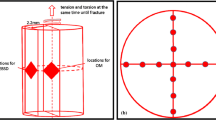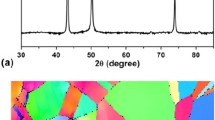Abstract
In the present study, a severe plastic deformation process of high-pressure torsion (HPT) has been modified. The new process is called high-pressure double torsion (HPDT) as both anvils of the conventional HPT process rotate in opposite directions. We manufactured sets of aluminum and pure copper samples using both the HPT process and the newly developed HPDT process to compare between microstructures and microhardness values. Our investigations showed that the copper samples processed by HPDT exhibited larger gradients in microstructure and higher values of hardness. Subsequently, we carried out a set of finite element simulations in ABAQUS/explicit to better understand the differences between the HPT process and the HPDT process. A comparison of the strain distributions of the HPT and HPDT samples revealed a decreasing trend in strain values as the radius increased at the middle surface of the samples. Analysis of the equivalent stress values revealed that stress values for the HPDT samples were higher than those of the HPT samples. Finally, the comparison of the max principal stress values indicated that in the HPDT sample, the extent of the compressive stresses was larger than those in the HPT sample.













Similar content being viewed by others
References
A.P. Zhilyaev and T.G. Langdon, Using High-Pressure Torsion for Metal Processing: Fundamentals and Applications, Prog. Mater Sci., 2008, 53(6), p 893–979
R.Z. Valiev, R.K. Islamgaliev, and I.V. Alexandrov, Bulk Nanostructured Materials from Severe Plastic Deformation, Prog. Mater Sci., 2000, 45(2), p 103–189
A. Zhilyaev et al., Experimental Parameters Influencing Grain Refinement and Microstructural Evolution During High-Pressure Torsion, Acta Mater., 2003, 51(3), p 753–765
A. Zhilyaev, T. McNelley, and T. Langdon, Evolution of Microstructure and Microtexture in FCC Metals During High-Pressure Torsion, J. Mater. Sci., 2007, 42(5), p 1517–1528
C. Xu, Z. Horita, and T.G. Langdon, Evaluating the Influence of Pressure and Torsional Strain on Processing by High-Pressure Torsion, J. Mater. Sci., 2008, 43(23–24), p 7286–7292
S.C. Yoon, Z. Horita, and H.S. Kim, Finite Element Analysis of Plastic Deformation Behavior During High Pressure Torsion Processing, J. Mater. Process. Technol., 2008, 201(1), p 32–36
M. Kawasaki, R.B. Figueiredo, and T.G. Langdon, An Investigation of Hardness Homogeneity Throughout Disks Processed by High-Pressure Torsion, Acta Mater., 2011, 59(1), p 308–316
Y. Cao et al., A Visualization of Shear Strain in Processing by High-Pressure Torsion, J. Mater. Sci., 2010, 45(3), p 765–770
Z. Horita and T.G. Langdon, Microstructures and Microhardness of an Aluminum Alloy and Pure Copper After Processing by High-Pressure Torsion, Mater. Sci. Eng. A, 2005, 410, p 422–425
F. Wetscher, A. Vorhauer, and R. Pippan, Strain Hardening During High Pressure Torsion Deformation, Mater. Sci. Eng. A, 2005, 410, p 213–216
H.S. Kim et al., Deformation Behavior of Copper During a High Pressure Torsion Process, J. Mater. Process. Technol., 2003, 142(2), p 334–337
A. Zhilyaev et al., Influence of the High Pressure Torsion Die Geometry on the Allotropic Phase Transformations in Pure Zr, Mater. Sci. Eng. A, 2010, 527(16), p 3918–3928
R. Lapovok et al., Severe plastic Deformation Processes for Thin Samples, J. Mater. Sci., 2010, 45(17), p 4554–4560
O. Bouaziz, Y. Estrin, and H.S. Kim, A New Technique for Severe Plastic Deformation: The Cone-Cone Method, Adv. Eng. Mater., 2009, 11(12), p 982–985
K. Edalati and Z. Horita, Continuous High-Pressure Torsion, J. Mater. Sci., 2010, 45(17), p 4578–4582
M. Jahedi et al., Texture Evolution and Enhanced Grain Refinement Under High-Pressure-Double-Torsion, Mater. Sci. Eng. A, 2014, 611, p 29–36
M. Knezevic et al., Modeling Bending of α-Titanium with Embedded Polycrystal Plasticity in Implicit Finite Elements, Mater. Sci. Eng. A, 2013, 564, p 116–126
M. Knezevic, H.F. Al-Harbi, and S.R. Kalidindi, Crystal Plasticity Simulations Using Discrete Fourier Transforms, Acta Mater., 2009, 57(6), p 1777–1784
M. Knezevic, S.R. Kalidindi, and D. Fullwood, Computationally Efficient Database and Spectral Interpolation for Fully Plastic Taylor-Type Crystal Plasticity Calculations of Face-Centered Cubic Polycrystals, Int. J. Plast., 2008, 24(7), p 1264–1276
M. Ardeljan, I.J. Beyerlein, and M. Knezevic, A Dislocation Density Based Crystal Plasticity Finite Element Model: Application to a Two-Phase Polycrystalline HCP/BCC Composites, J. Mech. Phys. Solids, 2014, 66, p 16–31
M. Knezevic et al., Texture Evolution in Two-Phase Zr/Nb Lamellar Composites During Accumulative Roll Bonding, Int. J. Plast., 2014, 57, p 16–28
ABAQUS, Reference Manuals, Dassault Systèemes, Providence, 2013
V.I. Levitas, High-Pressure Mechanochemistry: Conceptual Multiscale Theory and Interpretation of Experiments, Phys. Rev. B, 2004, 70(18), p 184118
H.S. Kim, Finite Element Analysis of High Pressure Torsion Processing, J. Mater. Process. Technol., 2001, 113(1), p 617–621
V.I. Levitas and O.M. Zarechnyy, Numerical Study of Stress and Plastic Strain Evolution Under Compression and Shear of a Sample in a Rotational Anvil Cell, High Pressure Res., 2010, 30(4), p 653–669
B. Feng and V.I. Levitas, Coupled Phase Transformations and Plastic Flows Under Torsion at High Pressure in Rotational Diamond Anvil Cell: Effect of Contact Sliding, J. Appl. Phys., 2013, 114(21), p 213514
R. Ebrahimi and A. Najafizadeh, A New Method for Evaluation of Friction in Bulk Metal Forming, J. Mater. Process. Technol., 2004, 152(2), p 136–143
N. Bay, Friction Stress and Normal Stress in Bulk Metal-Forming Processes, J. Mech. Work. Technol., 1987, 14(2), p 203–223
K. Edalati, Z. Horita, and T.G. Langdon, The Significance of Slippage in Processing by High-Pressure Torsion, Scripta Mater., 2009, 60(1), p 9–12
R.B. Figueiredo et al., Using Finite Element Modeling to Examine the Temperature Distribution in Quasi-constrained High-Pressure Torsion, Acta Mater., 2012, 60(6), p 3190–3198
R.B. Figueiredo, P.R. Cetlin, and T.G. Langdon, Using Finite Element Modeling to Examine the Flow Processes in Quasi-constrained High-Pressure Torsion, Mater. Sci. Eng. A, 2011, 528(28), p 8198–8204
A. Eivani and A. Karimi, Taheri, An Upper Bound Solution of ECAE Process with Outer Curved Corner, J. Mater. Process. Technol., 2007, 182(1), p 555–563
B. Mani, M. Jahedi, and M.H. Paydar, A Modification on ECAP Process by Incorporating Torsional Deformation, Mater. Sci. Eng. A, 2011, 528(12), p 4159–4165
M. Jahedi and M.H. Paydar, Three-Dimensional Finite Element Analysis of Torsion Extrusion (TE) as an SPD Process, Mater. Sci. Eng. A, 2011, 528(29), p 8742–8749
N. Pardis and R. Ebrahimi, Different Processing Routes for Deformation Via Simple Shear Extrusion (SSE), Mater. Sci. Eng. A, 2010, 527(23), p 6153–6156
H. Jiang et al., Microstructural Evolution, Microhardness and Thermal Stability of HPT-Processed Cu, Mater. Sci. Eng. A, 2000, 290(1), p 128–138
K. Edalati, T. Fujioka, and Z. Horita, Microstructure and Mechanical Properties of Pure Cu Processed by High-Pressure Torsion, Mater. Sci. Eng. A, 2008, 497(1), p 168–173
M. Kawasaki et al., The Development of Hardness Homogeneity in Pure Aluminum and Aluminum Alloy Disks Processed by High-Pressure Torsion, Mater. Sci. Eng. A, 2011, 529, p 345–351
Y. Cao et al., Three-Dimensional Shear-Strain Patterns Induced by High-Pressure Torsion and Their Impact on Hardness Evolution, Acta Mater., 2011, 59(10), p 3903–3914
C.I. Chang, C.J. Lee, and J.C. Huang, Relationship Between Grain Size and Zener-Holloman Parameter During Friction Stir Processing in AZ31 Mg Alloys, Scripta Mater., 2004, 51(6), p 509–514
A. Zhilyaev et al., Orientation Imaging Microscopy of Ultrafine-Grained Nickel, Scripta Mater., 2002, 46(8), p 575–580
M. Zehetbauer and R.Z. Valiev, Nanomaterials by Severe Plastic Deformation, Wiley Online Library, Weinham, 2004
Z. Horita et al., Observations of Grain Boundary Structure in Submicrometer-Grained Cu and Ni Using High-Resolution Electron Microscopy, J. Mater. Res., 1998, 13(2), p 446–450
M. Jahedi and M.H. Paydar, Study on the Feasibility of the Torsion Extrusion (TE) Process as a Severe Plastic Deformation Method for Consolidation of Al Powder, Mater. Sci. Eng. A, 2010, 527(20), p 5273–5279
A. Nagasekhar et al., Stress and Strain Histories in Equal Channel Angular Extrusion/Pressing, Mater. Sci. Eng. A, 2006, 423(1), p 143–147
Acknowledgments
MJ and MHP would like to acknowledge the financial support of Shiraz University through Grant Number 90-GR-ENG-16. The authors are indebted to all the technicians from the Fars Industrial Estate and are grateful for their technical input and support in 2012. During this time, the HPT machine was manufactured at Shiraz University. MK was supported by faculty start-up funds from the University of New Hampshire.
Author information
Authors and Affiliations
Corresponding author
Rights and permissions
About this article
Cite this article
Jahedi, M., Knezevic, M. & Paydar, M.H. High-Pressure Double Torsion as a Severe Plastic Deformation Process: Experimental Procedure and Finite Element Modeling. J. of Materi Eng and Perform 24, 1471–1482 (2015). https://doi.org/10.1007/s11665-015-1426-0
Received:
Revised:
Published:
Issue Date:
DOI: https://doi.org/10.1007/s11665-015-1426-0




